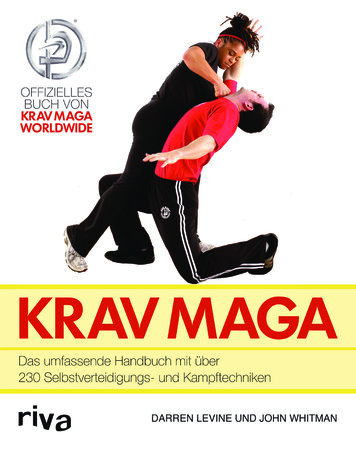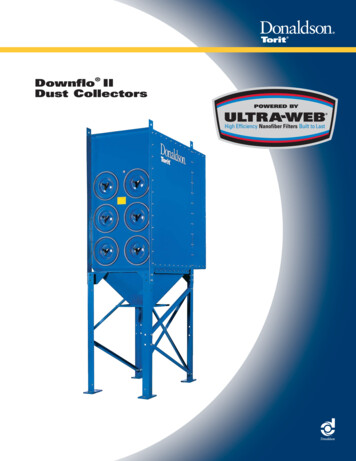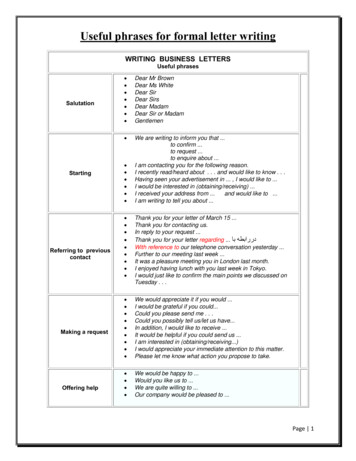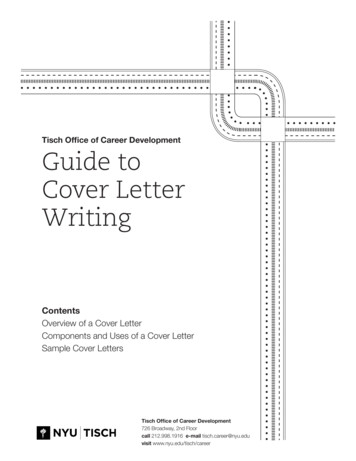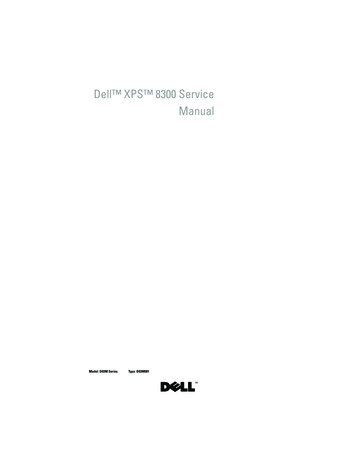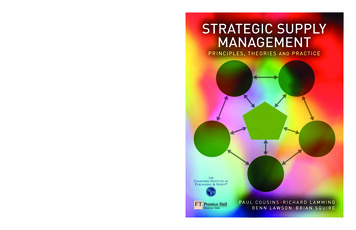
Transcription
9780273651000 COVER.qxd11/29/072:43 PMPage 1‘Cousins et al. have drawn from their extensive experience in industry, and crafted a book thatprovides deep contextual insights into why supply chains are the foundation for competitivestrategy, the dynamics that drive economic change, and most importantly, the importance ofrelationships as the glue that keeps supply chains functioning properly. Executives andstudents will benefit from the frameworks, examples, and discussions in this book, whichshould be on everyone who has an interest in global competitiveness’ bookshelves.’Rob Handfield, Bank of America University Distinguished Professor of Supply Chain Management,North Carolina State UniversityDevelopment of supply chain strategies has become a major growth industry in its own right; mostorganisations now see managing their supply chain as a key strategic issue. The main tenet of thisbook is that supply needs to be thought about as a dynamic strategic process, and not as abureaucratic business function.Strategic Supply Management: principles, theories and practice traces the development of purchasingand supply management from its origins as a tactical commercial function into a key strategicbusiness process. Integrating conceptual models, including the strategic supply wheel, with a host ofpractical examples, the authors illuminate the philosophy, concepts and techniques of supplymanagement. They also contrast the traditional, conventional concepts of purchasing and supplymanagement with new ideas, radical concepts, and examples of interesting practice.For a website to accompany this book visit www.pearsoned.co.uk/cousinslammingProfessor Paul Cousins The , Manchester Business SchoolProfessor Richard Lamming School of Management, University of SouthamptonDr Benn Lawson School of Management and Economics, Queen’s University BelfastDr Brian Squire The , Manchester Business SchoolCover image adapted with permission from Elsevieran imprint ofwww.pearson-books.comSTRATEGIC SUPPLYMANAGEMENTP R I N C I P L E S , T H E O R I E S A N D P R ACT I C EPAUL COUSINS RICHARD LAMMINGBENN LAWSON BRIAN SQUIREDesigned to provide a comprehensive course structure for teaching and studying thiswide-ranging and constantly developing topic, this book guides the reader through the subjectwith clarity and logic. Whether used as a course textbook or a source of reference, students andpractitioners will find the authors' comprehensive overviews of the topics indispensable.STRATEGIC SUPPLY MANAGEMENTP R I N C I P L E S , T H E O R I E S A N D P R ACT I C EP R I N C I P L E S , T H E O R I E S A N D P R ACT I C ESTRATEGIC SUPPLYMANAGEMENTPA U L C O U S I N S R I C H A R D L A M M I N GBENN LAWSON BRIAN SQUIRE
STRS A01.qxd19/11/200703:33PMPage iStrategic Supply Management‘Cousins et al. have drawn from their extensive experience in industry, and crafteda book that provides deep contextual insights into why supply chains are the foundation for competitive strategy, the dynamics that drive economic change, and mostimportantly, the importance of relationships as the glue that keeps supply chainsfunctioning properly. Executives and students will benefit from the frameworks,examples, and discussions in this book, which should be on the bookshelves ofeveryone who has an interest in global competitiveness.’Rob HandfieldBank of America University Distinguished Professor of Supply Chain ManagementNorth Carolina State UniversityConsulting Editor, Journal of Operations ManagementDirector, Supply Chain Resource Cooperative
STRS A01.qxd19/11/200703:33PMPage iiWe work with leading authors to develop thestrongest educational materials in management,bringing cutting-edge thinking and bestlearning practice to a global market.Under a range of well-known imprints, includingFT Prentice Hall, we craft high quality print andelectronic publications which help readers to understandand apply their content, whether studying or at work.To find out more about the complete range of ourpublishing, please visit us on the World Wide Web at:www.pearsoned.co.uk
STRS A01.qxd19/11/200703:33PMPage iiiStrategic Supply ManagementPrinciples, Theories and PracticeProfessor Paul CousinsProfessor of Operations ManagementCIPS Professor of Supply Chain ManagementThe , Manchester Business SchoolProfessor Richard LammingDirectorSchool of Management, University of SouthamptonDr Benn LawsonSenior Lecturer in Operations ManagementCIPS Research FellowSchool of Management and Economics, Queen’s University BelfastDr Brian SquireLecturer in Operations and Supply Chain ManagementThe , Manchester Business School
STRS A01.qxd19/11/200703:33PMPage ivPearson Education LimitedEdinburgh GateHarlowEssex CM20 2JEEnglandand Associated Companies throughout the worldVisit us on the World Wide Web at:www.pearsoned.co.ukFirst published 2008 Paul Cousins, Richard Lamming, Benn Lawson and Brian Squire 2008The rights of Paul Cousins, Richard Lamming, Benn Lawson and Brian Squire to be identified as authorsof this work have been asserted by them in accordance with the Copyright, Designs and Patents Act 1988.All rights reserved. No part of this publication may be reproduced, stored in aretrieval system, or transmitted in any form or by any means, electronic, mechanical,photocopying, recording or otherwise, without either the prior written permission of thepublisher or a licence permitting restricted copying in the United Kingdom issued by theCopyright Licensing Agency Ltd, Saffron House, 6–10 Kirby Street, London EC1N 8TS.All trademarks used herein are the property of their respective owners. The use of anytrademark in this text does not vest in the author or publisher any trademark ownership rightsin such trademarks, nor does the use of such trademarks imply any affiliation with or endorsementof this book by such owners.ISBN: 978-0-273-65100-0British Library Cataloguing-in-Publication DataA catalogue record for this book is available from the British Library10 9 8 7 6 5 4 3 2 112 11 10 09 08 07Typeset in 10/12.5pt Sabon by 35Printed by Ashford Colour Press Ltd., GosportThe publisher’s policy is to use paper manufactured from sustainable forests.
STRS A01.qxd19/11/200703:33PMPage vThe authors would like to express their thanks to their familiesfor help throughout the years.Joan and David Cousins, Julia, Tony, Ash and EllyPDCLeigh, Louise and Rosie LammingRCLNorman and Dawn Lawson, Karen, Lauren, Kate and CoreyBRLCliff and Jill SquireBCS
STRS A01.qxd19/11/200703:33PMPage vi
STRS A01.qxd19/11/200703:33PMPage viiContentsList of figuresList of tablesList of boxesPrefaceAcknowledgementsAbbreviationsPart 1THE FUNDAMENTALS OF SUPPLYxviixxxxixxiixxiiixxvi1Chapter 1The supply challenge3IntroductionStructure of the bookPart 1: The fundamentals of supplyPart 2: Developing supply strategyPart 3: Strategic issues in supply managementPart 4: Future directionsA note on terminologyOverviewWhy should purchasing be seen as important to an Chapter 2The evolution of purchasing and supply management10IntroductionThe evolution of purchasingThe 1940s–1960s: logisticsThe 1970s: purchasing as an administrative functionThe 1980s: purchasing as supply chain managementThe 1990s: supply management and strategic decision makingDrivers of purchasing evolutionPolitical pressuresEconomic pressuresSocial pressuresTechnological pressures1011111112131515161717
STRS A01.qxd19/11/200703:33PMPage viiiviii ContentsThe role of the purchasing functionImplementing strategySupporting strategyDriving strategyJudging purchasing’s contribution to strategyStage 1: PassiveStage 2: IndependentStage 3: SupportiveStage 4: IntegrativeEmpirical taxonomies of purchasingStrategic purchasersCapable purchasersUndeveloped purchasersCelebrity purchasersMoving between phasesThe scope of strategic supply managementSummarySeminar 22222222324242525Chapter 3The make–buy decision: a theoretical perspective27IntroductionThe make–buy decisionThe inadequacy of neoclassical economic theoryThe transaction cost approachBehavioural characteristicsTransaction characteristicsTCE and the make–buy decisionTCE criticismsThe capability urce-based view and the make–buy decisionSummarySeminar 53538394042Chapter 4Sourcing strategies and supply chain configurations43IntroductionSupply base reductionSourcing strategies434347
STRS A01.qxd19/11/200703:33PMPage ixContents ixSupply market complexityImpact on businessStrategic directions for managing category spendsSupply structure and designSingle sourcingMultiple sourcingDelegated sourcing strategyParallel sourcingSummarySeminar questionsReferencesFurther readingEndnotes48495052525354555757575858Chapter 5Strategic supplier selection59IntroductionMain stages of supplier selectionStep 1: Initial supplier qualificationStep 2: Agree measurement criteriaCost criteriaQuality criteriaDelivery criteriaFlexibility criteriaOther criteriaStep 3: Obtain relevant informationStep 4: Make selectionAssign weights to criteriaCalculate criteria weightsEvaluate individual suppliersCalculate supplier weightsSummarySeminar 071727273737474Chapter 6Supplier development75IntroductionDefining supplier developmentObjectives of supplier developmentSupplier development strategiesBest practices in supplier developmentThe supplier development processStep 1: Identify critical commoditiesStep 2: Identify critical suppliers7575788183838484
STRS A01.qxd19/11/200703:33PMPage xx ContentsStep 3: Form a cross-functional teamStep 4: Meet with supplier top managementStep 5: Identify key projectsStep 6: Define details of agreementStep 7: Monitor status and modify strategiesBarriers to supplier developmentSummarySeminar questionsReferencesEndnotesPart 2DEVELOPING SUPPLY STRATEGY8585868686868787878889Chapter 7Supply strategy: the development of the strategicsupply wheel91IntroductionThe origins of the strategic supply wheelRationale of the supply wheelAppropriatenessStrategic planning toolLinkage with sourcing strategies and Kraljic’s positioning modelOverview of each elementAlignment of corporate and supply strategy (Chapter 8)Skills and competencies (Chapter 9)Organisational structure (Chapter 10)Strategic performance measures (Chapter 11)Cost–benefit analysis (Chapter 12)Relationship portfolio (Chapter 13)SummaryReferencesFurther reading91919494949495959596969697989898Chapter 8Aligning supply with corporate strategy99IntroductionWhat is strategy?Levels of strategy within organisationsWhat is strategic alignment?Aligning purchasing and corporate strategiesThe process of aligning supply and corporate strategies99101102103104105
STRS A01.qxd19/11/200703:33PMPage xiContents xiDeveloping corporate strategySetting corporate prioritiesTranslating competitive priorities into supply function objectivesTranslating supply function objectives into supply chain practicesSummarySeminar 0Chapter 9Competency and skills development for strategic supply111IntroductionThe nature of skills, competency and competenceThe integration of competencies and competencesCompetency and competence requirements for strategic supplyPurchasing Competency Development ModelStep 1: Strategic stanceStep 2: Purchasing objectives and themesStep 3: Prioritised competenciesStep 4: Development methodologyStep 5: Purchase integrationStep 6: Evaluation of benefitsSummarySeminar questionsReferencesFurther 25Chapter 10Organisational structures for supply management126IntroductionConceptual frameworkApplying the concepts: the development of organisational designChallenges, issues and practical aspects: principal choicesfor organising nFederal structureHybrid systemsFrom classical to radicalSummarySeminar 9140142142143143143
STRS A01.qxd19/11/200703:33PMPage xiixii ContentsChapter 11Performance measurement144IntroductionPerformance measures as signalling devicesCascading performance measuresThe benefits of measurementProblems with measurementKey performance measurement conceptsEfficiency versus effectivenessWhy can cost-based measures be dysfunctional?Financial and non-financial measuresIdentify the stakeholdersGaining buy-inCategories of performance measuresCostQualityTimeSupplier performanceCustomer satisfactionDeveloping a performance measurement systemSummarySeminar questionsReferencesFurther 54154154155159160160160Chapter 12Cost–benefit analysis161IntroductionThe measurement of costsPrice versus costTotal cost of ownershipUncovering the hidden costs of ownershipSummarySeminar questionsReferencesFurther reading161162163165165169169169169Chapter 13Managing inter-firm relationships170IntroductionA strategic approach: the development of supply chain andrelationship managementRelationship definitions and misconceptions: towards amanagement model170174175
STRS A01.qxd19/11/200703:33PMPage xiiiContents xiiiDevelopment of a relationship management approachThe management of dependencies and certaintiesThe implementation of relationship managementThe Partnership Life Cycle EffectThe Partnership Expectations EffectThe Partnership Desert EffectImplications for managing relationshipsSummarySeminar questionsReferencesFurther readingEndnotesPart 3STRATEGIC ISSUES IN SUPPLY CHAIN hapter 14Environmental and ethical issues in supply management195IntroductionWhy should Purchasing be concerned?Sustainability, green, and environmental soundnessPurchasing and supply management’s environmental contributionUnderstanding pollutionEstablishing a policy on environmental soundnessStrategy for minimising impactsRisks for Purchasing and Supply managersImplementation issuesMeasuring environmental effectivenessSupplier assessmentStrategy and senior management commitmentSummarySeminar questionsReferencesFurther 1212212212214215Chapter 15Involving suppliers in new product development216IntroductionAdvantages of ESIDisadvantages of ESISelecting the right suppliersThe timing of supplier involvement216219220221222
STRS A01.qxd19/11/200703:33PMPage xivxiv ContentsThe extent of supplier involvementManaging the involvementSummarySeminar er 16Public and regulated supply management227The contextIntroduction: the differenceWhat is public?Why is the European Union relevant to UK public procurement?What is a ‘significant’ level of spend?The EC Directives and UK Contracts RegulationsObserving the thresholdsThe proceduresOpen procedureRestricted procedureCompetitive dialogueNegotiated proceduresDynamic purchasing system (DPS)Do the Directives work?Examples of public sector procurementSummarySeminar questionsReferencesFurther 0241241242242243243243244Chapter 17Electronic supply246IntroductionDevelopment of the enabling technologyElectronic data interchangeEarly Internet marketsMany to many: the emergence of hubsContent on offer from exchangesOnline auctionsSummarySeminar questionsReferencesFurther 7
STRS A01.qxd19/11/200703:33PMPage xvContents xvChapter 18The relevance of commodities259IntroductionThe principle of commodityTypes of commodityDealing with the problems of fluctuating pricesPrivate dealsBackward integrationOpportunistic buyingBuying on the future marketSummarySeminar questionsReferencesFurther 2272Chapter 19Services procurement273IntroductionService characteristicsService classificationsPurchasing services: a taxonomy-based approachDeveloping a strategy for services purchasingStage 1: AnalysisStage 2: FocusStage 3: Contract developmentStage 4: Relationship strategyStage 5: ImplementationStage 6: FeedbackSummarySeminar questionsReferencesFurther 6286287287287Part 4FUTURE DIRECTIONS289Chapter 20The future – a trajectory for supply management291IntroductionSummary and conclusion of the bookTheory development in supply chain management291291292
STRS A01.qxd19/11/200703:33PMPage xvixvi ContentsFuture directions in supply managementWhat will supply management look like in the futurefor practitioners?The future for purchasing and supply – an allegoryMaking sense of the allegorySeminar questionsReferencesFurther readingEndnotes293Index301293294297299299299300
STRS A01.qxd19/11/200703:33PMPage xviiList of 8.38.49.19.29.39.49.59.69.7The pedagogical approachThe strategic supply wheelInput, Transformation Output ModelDrivers of strategic purchasingTaxonomy of purchasing functionsChanging unit of analysis in supply structureBoundaries of the firmTCE and the ‘make–buy’ decisionTransaction curve costs for make versus buyThe resource-based approach to the make–buy decisionThe effects of supply base reductionKraljic product and service positioning matrixFive forces shaping market competitivenessThe Pareto analysis: ABCSingle sourcingMultiple sourcingDelegated sourcing strategyParallel sourcingGeneric mapping of sourcing strategy and sourcing structuresStrategic supplier selectionPrice versus total costsThe selection hierarchyUsing AHP to select suppliersSupplier development and a world-class supply baseSupplier development outcomesTypology of supplier development activitySupplier development processThree basic approaches to strategic supplyThe strategic supply wheelThe strategic supply wheelThe process of strategic alignmentMatching supply chain strategy with productsThe process of aligning supply and corporate strategiesThe strategic supply wheelThe strategic alignment modelRoberts’ competencies frameworkStrategic supply competency tableThe Purchasing Competency Development ModelRelationship positioning matrixDisaggregation of purchasing 6970767980849293100103105106112112115117119120121
STRS A01.qxd19/11/200703:33PMPage xviiixviii List of .317.117.217.317.417.517.617.717.818.118.2The strategic supply wheelCentralisation of purchasingDecentralisation of purchasingAtomisation of purchasingFederal structures in purchasingThe strategic supply wheelHierarchy of performance measuresDefinitionsCategories of performance measurementDesigning a purchasing performance measurement systemA sample Purchasing Balanced ScorecardThe strategic supply wheelPrice/cost modelPurchasing’s activities contributing to total cost of ownershipThe strategic supply wheelRelationship resourcesThe strategic supply wheelThe Strategic Focused Outcomes Model (SFOM)Strategic Relationship Positioning ModelAlignment of strategies, relationships and skillsThe Partnership Life Cycle EffectThe Partnership Expectations EffectDevelopment of relationship sourcing strategiesThe Partnership Desert EffectThe broad constituent elements of sustainable developmentMatter cannot be destroyed, only convertedA process view of the business organisationThe waste hierarchyThe product stewardship conceptDevelopment of Kraljic’s model to incorporate environmental concernDesign flexiblity and cost of design changesTiming of supplier involvementExtent of supplier involvementThe open procedure for public contractsThe restricted procedure for public contractsThe negotiated procedures for public contractsElectronic data interchangeOne-to-many e-commerceThe emergence of exchanges or hubs: late 1990sCollaboration between exchanges or hubsDirect content from several suppliers to a private exchangeAggregated content from a site containing several sources ofgoods and servicesThe portal principleThe portal principle, showing a recommendation’s serviceSimplified representation of the relationships between commodity priceand the futures price: ‘a perfect hedge’A more realistic representation of the relationships between commodityprice and the futures price: ‘complex 218222223236238240249250251252253254254254269269
STRS A01.qxd19/11/200703:33PMPage xixList of figures19.119.219.319.419.5The service delivery programmePurchasing services matrixStages in the development of a purchasing services strategyFocus of servicesImplementation – the wave approachxix275281284285286
STRS A01.qxd19/11/200703:33PMPage xxList of 12.113.113.216.116.218.1Strategic stages in the development of a purchasing functionSummary of the assumptions of Transaction Cost EconomicsRequests for proposals, information and quotationsCriteria for supplier selectionSelection criteria for functional versus innovative productsMeasurement scale for pairwise comparisonsPairwise comparison matrix (original matrix)Calculating criteria weights (adjusted matrix)Pairwise comparison of suppliers for innovation, quality and price criteriaFinal weights and comparison of alternativesKey barriers to successful supplier developmentCompetitive priorities for supplyValue-adding activities which Purchasing may undertakeCharacteristics of effective performance measurement systemsThe total cost of ownership matrixThe four key dependenciesThe four levels of certaintyThresholds from 31 January 2006Thresholds: Utilities sectors from 31 January 2006Examples of major commodity 33233265
STRS A01.qxd19/11/200703:33PMPage xxiList of 5.115.215.318.118.218.319.119.219.319.4Traditional view of the impact of purchasingGrowth in supply chain consultancySupply strategy as the delivery of corporate strategyPalm ComputingIntegration of supply chain activitiesSupply in action: Vertical integration in the oil and gas industryDiscussion: Is RBV a complete theory?Supply in action: Developing contact lens capabilities at Johnsonand JohnsonExamples of strategic supply base reductionAutomotive industry supply delegationSupply in action: Fire at EricssonCritique of quality certificationWhat are multi-criteria decision-making models?Limitations of AHPSupplier development at John DeereSaint GobainStrategic alignmentThe cost of businessStrategic alignment in the public sectorA definition of strategyCriticisms of competency-based approachesCould you be a world-class Supply Strategist?North West Universities Purchasing Consortium LimitedComet introduces supply chain performance measurementDissatisfied customersThe true cost of ownership?How hard is it to define a relationship?Social policiesMobile phones and African warsSupplier involvement at DelphiDeveloping joint technology roadmapsESI at SmartOil prices dive on plane bomb plotRising fuel prices take their tollUsing hedges to reduce risk: simple examplesAn example of a service level agreementNew computer system for NHS to improve patient careNHS IT upgrade – managing a multi-million pound projectNew action for cleaner, safer hospitals, 2146163166172200201217220224263268270277278279283
STRS A01.qxd19/11/200703:33PMPage xxiiPrefaceThe original idea for this book emerged in 2002: four years ago, as we write thispage. It began with Paul Cousins and Richard Lamming discussing the lack of astructured strategically focused text for teaching supply management. Instead ofbemoaning it, we decided to write the text ourselves. Having embarked on theexercise we realised why such a text did not exist! The subject area is vast, wideranging and still developing. During the first few years of the project, Richard tookup the Directorship of the School of Management at the University of Southamptonand Paul spent time working in Melbourne, Australia, at Queen’s University Belfastand eventually settled at Manchester Business School, The .In 2005 we decided that this book would not be completed without further authors.It was at this point that we recruited Dr Benn Lawson (Queen’s University Belfast)and Dr Brian Squire (Manchester Business School) to help with the writing. Thisproved to be an excellent choice and both Benn and Brian have worked extremelyhard to make the book into what it is today.
STRS A01.qxd19/11/200703:33PMPage xxiiiAcknowledgementsAuthors’ acknowledgementsCreating a book of this size and time scale involves a large number of people inaddition to those listed on the front cover. This section affords us the opportunityto formally thank those people that have supported us and enabled this book tocome to fruition.First, we should like to thank those people who have had a direct involvementin the production of the book. One of the most important people in helping us toget organised and deliver this text on time was Lesley Gilchrist. Lesley has workedtirelessly with us: she has helped to typeset the entire text, kept us focused andmade sure everything was presented in a coherent and uniform manner. We arevery grateful to Lesley for her help and professional attitude: thank you, Lesley.Secondly, we would like to thank our Research Assistant Craig Artley. Craig hasprovided background research for every chapter. He has also helped in the management process. Craig leaves us in September 2006 to pursue a postgraduate degreeand we wish him well with his future endeavours. Third, we should like to acknowledge the important contribution to Chapter 16 made by Mr Fred Harvey, one ofthe UK’s leading experts on European Procurement regulation. Finally, we wouldlike to thank Sam Alford who took over the management of the book and throughher perseverance and tenacity made sure that the authors delivered a timely andquality product – thanks very much, Sam.Next, we should like to thank our anonymous reviewers for their helpful andencouraging comments. We would also like to thank our publishers, commissioning editor and editorial adviser Matthew Oxenham and in the latter stages MatthewSmith for his management of this book project.Finally, we should like to thank our families, friends and partners for supporting us during the writing of this text. Anyone who has taken on a large projectwill know how time consuming and draining such a project is. Whilst work colleagues can offer professional support, it is families and friends that take most ofthe strain. We would like to thank them for their help and support. Specificallywe would like to thank Leigh Lamming, Jennifer Cassels and Karen Coyle.Publisher’s acknowledgementsWe are grateful to the following for permission to reproduce copyright material:Figure 1.2, Figure 7.2, Figure 8.1, Figure 9.1, Figure 9.6, Figure 10.1, Figure 11.1,Figure 12.1, Figure 13.1 and Figure 13.3 reprinted from European Journal of
STRS A01.qxd19/11/200703:33PMPage xxivxxiv AcknowledgementsPurchasing and Supply Management, 8 (2), Cousins, P. D., A conceptual modelfor managing long-term inter-organisational relationships, 71–82, Copyright(2002), with permission from Elsevier; Figure 2.4 from Developing the concept ofsupply strategy in International Journal of Operations & Production Management, Emerald Group Publishing Limited (Harland, C. M., Lamming, R. C. andCousins, P. D. 1999); Table 2.1 this article was published in Journal of Purchasingand Materials Management, 24, Reck, R. F. and Long, B. G., Purchasing: a competitive weapon, pp. 2–8, Copyright Elsevier (1988); Box 2.1 from www.clearspeed.com, ClearSpeed Technology plc (note that information published on theClearSpeed Website may be subject to change); Figure 2.3 from An empiricaltaxonomy of purchasing functions, in International Journal of Operations andProduction Management, Emerald Group Publishing Limited, (Cousins, P. D.,Lawson, B. and Squire, B. 2006); Figure 3.3 reprinted from ComparativeEconomic Organization: The Analysis of Discrete Structural Alternatives by OliverE. Williamson published in Administrative Science Quarterly, Volume 36, June bypermission of Administrative Science Quarterly, Volume 36. Johnson GraduateSchool of Management, Cornell University; Box 3.3 from Twenty five years of contact lenses: the impact on the cornea and ophthalmic practice in Cornea: The Journalof Cornea and External Diseases 19 (5), pp. 730–40, Lippincott, Williams & Wilkins(McMahon, T. O. D. and Zadnik, K. 2000); Figures 4.2 and 9.4 from Purchasingmust become supply management in Harvard Business Review, Harvard BusinessSchool Publishing (Kraljic, P. 1983); Figure 4.3 adapted with the permission ofThe Free Press, a Division of Simon & Schuster Adult Publishing Group, fromCOMPETITIVE ADVANTAGE: Creating and Sustaining Superior Performance byMichael E. Porter. Copyright 1985, 1998 by Michael E. Porter. All rights reserved;Figure 6.3 from Sako, M., Supplier development at Honda, Nissan and Toyota:comparative case studies of organizational capability enhancement, Industrialand Corporate Change, (2004), 13 (2), pp. 281–308, by permission of OxfordUniversity Press; Box 6.2 from www.unctad.org, United Nations; Figure 6.4 fromAvoid the pitfalls in supplier development in MIT Sloan Management Review(Handfield, R. B. et al. 2000). Copyright 2000 by Massachusetts Institute ofTechnology. All rights reserved. Distributed by Tribune Media Services; Box 8.2from Strategies for Change: Logical Incrementalism, The McGraw-Hill Companies, Inc., (Quinn, J. B. 1980); Figure
book is that supply needs to be thought about as a dynamic strategic process, and not as a bureaucratic business function. Strategic Supply Management: principles, theories and practicetraces the development of purchasing and supply management from its origins as a tactical c

